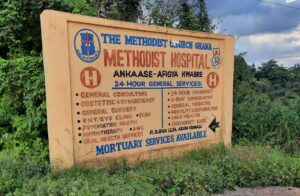
We spent this week in the OBGYN departments. Throughout the week, we rotated between the labor ward, the antenatal clinic, the obstetrics ward, and the operating theater for c-sections.
It’s hard to describe exactly how different practicing medicine is here when compared to in the States. In some areas, I see many similarities, such as in the medical protocols, attention to detail, and methods of teaching. In other areas, the two couldn’t be more different. For example, the hospital is open air, and you see goats and chickens walking in and out of the courtyards. Wards are small, made of one or two rooms where multiple beds are separated by curtains. There is less reliance on computers and less tech available for each patient.
The hospital staff are incredibly resourceful. For example, in the NICU, two infants needed a CPAP machine but there were none available. In response to this, the staff made their own from two oxygen tanks, tubing, and a water bottle (don’t ask me how it works, but it does!). In the operating theater, drapes and gowns are sterilized and reused.
With each interaction, you can tell the depth of compassion and care each nurse and physician has for their patients. Visits are less hurried, and physicians work with the patient to balance testing and medication that they need with what they can afford.
While in the antenatal clinic, midwives helped us learn how to palpate for fundal height, determine presentation, and check for FHR. In the US, physical exams are less relied upon since there is easier access to imaging. I know for myself, my physical exam skills are severely lacking, so I am really appreciative of the midwives taking the time to teach us. We work mostly with the nursing staff and midwives, who perform most of the deliveries. Physicians round in the mornings, are on call for any complications, and perform the c-sections.
While in the labor ward, I got to watch twins be delivered, a girl and a boy, which was special to see.
We also got to join two c-sections in the operating theater. The first case was elective, which I scrubbed in for. The surgeon was incredibly patient and was great at teaching as he operated. During the procedure, we incidentally found that the baby was cyanotic and had the cord wrapped around his neck, so things had to move quickly after that discovery. Thankfully, the baby quickly began breathing on his own and was okay.
The second c-section was emergent due to fetal distress. Again, it was found that the cord was wrapped around the baby’s neck during the procedure. This baby also began breathing as soon as the cord was removed and is doing okay as well.
